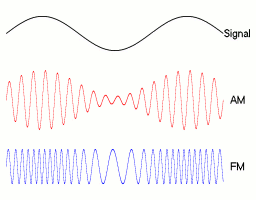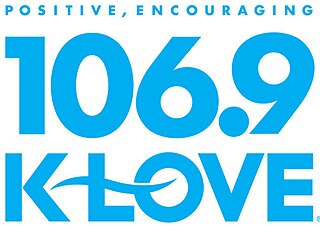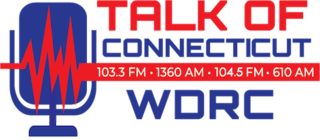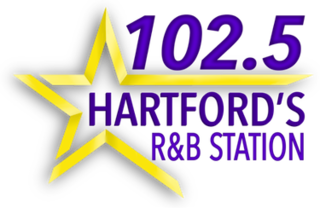FM broadcasting in the United States began in the 1930s at engineer and inventor Edwin Howard Armstrong's experimental station, W2XMN. The use of FM radio has been associated with higher sound quality in music radio.

KALW (91.7 MHz) is an educational FM public radio station, licensed to the San Francisco Unified School District (SFUSD), which serves the San Francisco Bay Area. Its studios are located at Phillip and Sala Burton Academic High School off Mansell Avenue in San Francisco, and its transmitter tower is on Twin Peaks.
WQXR-FM is an American non-commercial classical radio station, licensed to Newark, New Jersey, and serving the North Jersey and New York City area. It is owned by the nonprofit organization New York Public Radio (NYPR), which also operates WNYC (AM), WNYC-FM and the four-station New Jersey Public Radio group. WQXR-FM broadcasts from studios and offices located in the Hudson Square neighborhood in lower Manhattan and its transmitter is located at the Empire State Building. The station is the core audio service for NYPR's WQXR brand.

FM broadcasting is a method of radio broadcasting that uses frequency modulation (FM) of the radio broadcast carrier wave. Invented in 1933 by American engineer Edwin Armstrong, wide-band FM is used worldwide to transmit high-fidelity sound over broadcast radio. FM broadcasting offers higher fidelity—more accurate reproduction of the original program sound—than other broadcasting techniques, such as AM broadcasting. It is also less susceptible to common forms of interference, having less static and popping sounds than are often heard on AM. Therefore, FM is used for most broadcasts of music and general audio. FM radio stations use the very high frequency range of radio frequencies.

WNYE is a non-commercial educational FM radio station licensed to New York, New York. The station is operated, along with WNYE-TV, by NYC Media, a division of the Mayor's Office of Media and Entertainment. Studios are located at the City University of New York's Graduate Center at 365 Fifth Avenue, and the transmitter is at the former Condé Nast Building.

WKSS is an American radio station operated by iHeartMedia, Inc. in the Greater Hartford area. It broadcasts from its original transmitter site in Meriden, and has a rare dual city of license of Hartford–Meriden.

WCCC (106.9 FM) – branded K-Love – is a non-commercial contemporary Christian radio station licensed to serve Hartford, Connecticut. Owned by the Educational Media Foundation, WCCC does not broadcast any local programming, functioning as the K-Love network affiliate for Greater Hartford, the Pioneer Valley and portions of the Naugatuck Valley. The station's transmitter is located in West Hartford; in addition to a standard analog transmission, WCCC is also available online.

WRVE is a commercial radio station licensed in Schenectady and serving the Capital District and Upper Hudson Valley in New York. It broadcasts a hot adult contemporary radio format and calls itself "99.5 The River", referring to the Hudson River. The station is owned by iHeartMedia as one of seven radio stations owned by the company in the Albany-Schenectady-Troy radio market.

WUKY is a listener-supported, public radio station in Lexington, Kentucky. Owned by the University of Kentucky (UK), it has an Adult Album Alternative radio format, airing more than 100 hours of music per week. Some news and informational programming is supplied by National Public Radio (NPR), Public Radio International (PRI), American Public Media (APM) and the BBC. The station broadcasts from state of the art radio studios in northwestern Lexington at the intersection of Greendale Road and Spurr Road.

WDRC-FM is a radio station with a classic rock format licensed to Hartford, Connecticut. The station began broadcasting in 1959 and was the first commercial FM station in the Hartford radio market. The station is owned by John Fuller's Red Wolf Broadcasting Corporation, with studios located on Blue Hills Avenue in Bloomfield, Connecticut, with other radio stations and a transmitter site in Meriden, Connecticut.

WPOP is a commercial radio station in Hartford, Connecticut, broadcasting a news–talk–sports radio format. The station is owned by iHeartMedia, Inc. The studios and offices are located on Columbus Boulevard in Hartford.

WDRC is a commercial AM radio station in Hartford, Connecticut. It is owned by Full Power Radio and airs a conservative talk radio format. The studios and transmitter site are located on Blue Hill Avenue in Bloomfield, Connecticut, with other radio stations.

WELI is an AM commercial radio station licensed to New Haven, Connecticut, and serving the New Haven and Bridgeport areas. It broadcasts a news/talk radio format and is owned by iHeartMedia, Inc. WELI's studios are in Radio Towers Park on Benham Street in Hamden, where it shares facilities with sister stations WKCI-FM and WAVZ. Transmitting towers for WELI are also at this location.

WBOM is a commercial radio station licensed to Meriden, Connecticut, and covering Central Connecticut. The station broadcasts an urban adult contemporary format, aimed at the Hartford area. The station is owned by Full Power Radio, through Red Wolf Broadcasting Corporation. WBOM's programming is also heard on FM translator W273DS (102.5); the station's branding emphasizes the FM frequency.
W2XMN was an experimental FM radio station located in Alpine, New Jersey. It was constructed beginning in 1936 by Edwin Howard Armstrong in order to promote his invention of wide-band FM broadcasting. W2XMN was the first FM station to begin regular operations, and was used to introduce FM broadcasting to the general public in the New York City area. The station, in addition to being a testing site for transmitter and receiver development, was used for propagation studies and as an over-the-air relay station for distributing network programming to other FM stations in the region.
KE2XCC, first authorized in 1945 with the call sign W2XEA, was an experimental FM radio station located in Alpine, New Jersey and operated by inventor Edwin Howard Armstrong. It was located at the same site as Armstrong's original FM station, W2XMN, which dated to the late 1930s and primarily transmitted on the original FM "low band" frequencies. W2XEA was established as a companion station operating on the new FM "high band", which had been recently designated by the Federal Communications Commission as the replacement for the original FM station assignments. W2XMN shut down in 1949 after the "low band" was eliminated, and at this time W2XEA changed its call sign to KE2XCC and took over most of the functions previously performed by W2XMN.
WFMN was a commercial FM radio station located in Alpine, New Jersey. It was licensed from 1941 until around 1953 to inventor Edwin Howard Armstrong, and was co-located with two other Armstrong stations, W2XMN, and W2XEA/KE2XCC (1945-1954). However, for most of its existence WFMN was authorized for significantly lower power than the other two stations, and appears to have rarely been on the air.
WGTR was a pioneer commercial FM radio station, which was the first of two mountain-top stations established by the Yankee Network. It began regular programming, as experimental station W1XOJ, in 1939. In 1941 it was licensed for commercial operation from studios in Boston, initially with the call sign W43B, which was changed to WGTR in 1943. In 1947, its designated community of license was changed to Worcester, Massachusetts.

Franklin Malcolm Doolittle was a radio industry pioneer, who founded WDRC, the oldest AM station in Connecticut, in addition to that state's first FM station, WHCN, which was also one of the first FM broadcasters in the United States. In 1924–1925, he conducted the first tests made of stereo radio broadcasts.
WTHT was a radio station in Hartford, Connecticut, United States, that operated from 1936 to 1954. It was owned by The Hartford Times, the city's afternoon daily newspaper. As a result of the merger of WTHT with WONS, which brought the companies together in anticipation of building a television station, WTHT closed on February 15, 1954, and its programs were merged with WONS as WGTH on the WONS frequency. Its studios on 555 Asylum Street were converted into television facilities for WGTH-TV, which debuted later that year. The 1230 frequency was occupied by Manchester, Connecticut–based WINF beginning in 1958.














